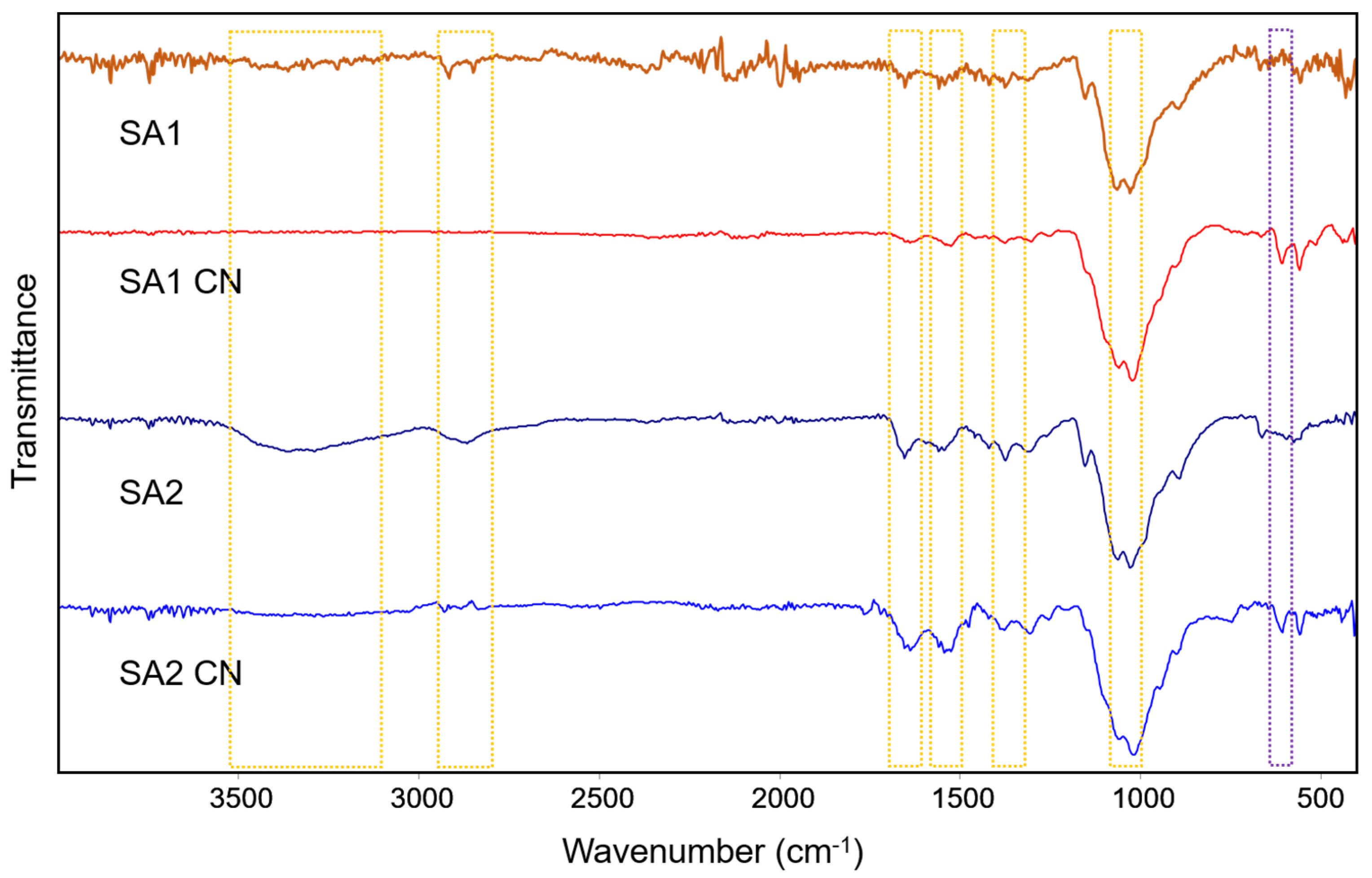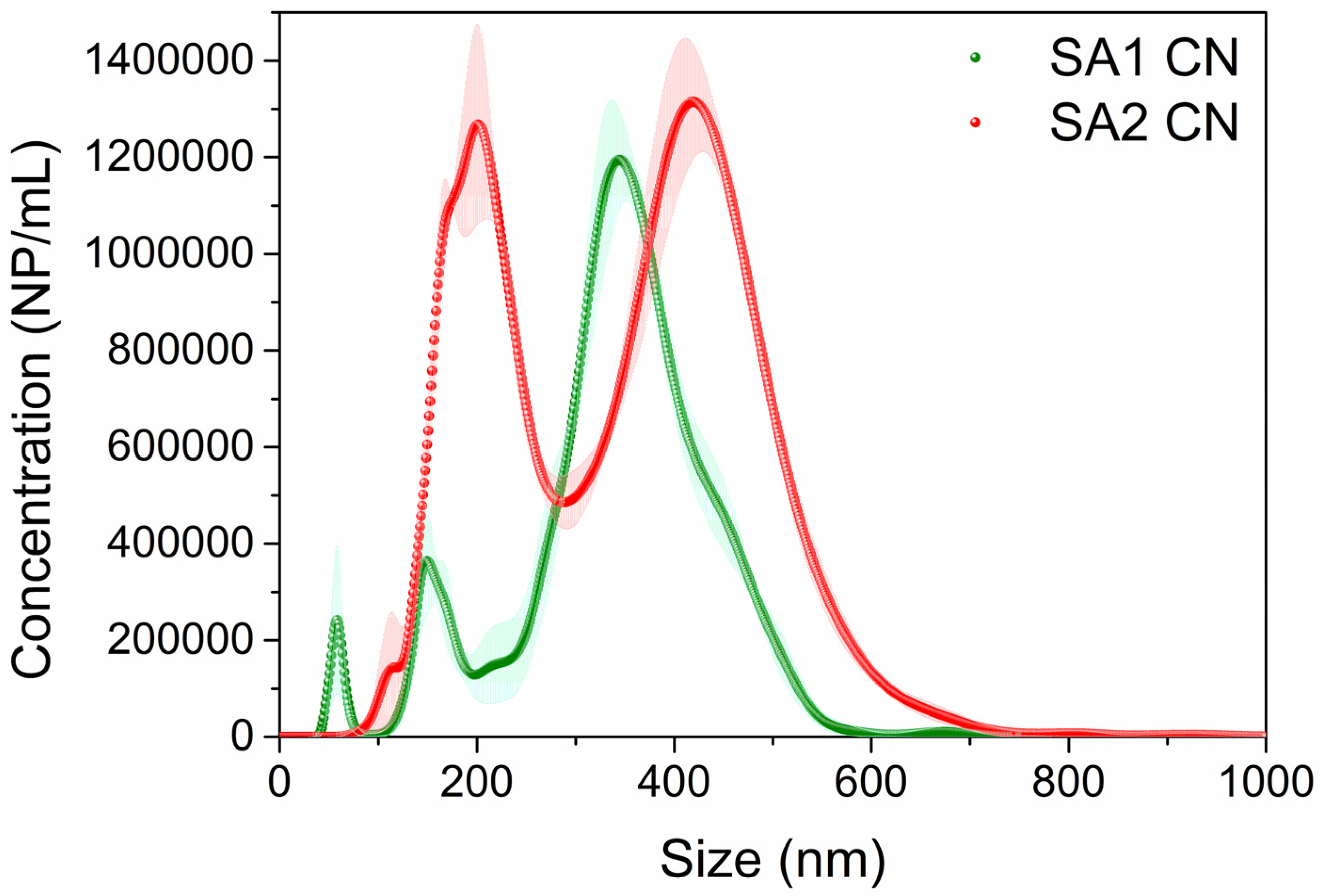Evaluation of the Antimicrobial Activity of Chitosan Nanoparticles against Listeria monocytogenes
Abstract
:1. Introduction
2. Results
2.1. CN Synthesis
2.2. CN Characterization
2.2.1. CN Size and Zeta (ζ) Potential
2.2.2. Minimum Inhibitory Concentration (MIC)
3. Discussion
4. Materials and Methods
4.1. Bacterial Strains, Culture Media, and Inoculum Preparation
4.2. Chitosan Selection, CN Synthesis, and Characterization
4.2.1. Chitosan Selection
4.2.2. CN Synthesis
4.2.3. CN Characterization
Attenuated Total Reflectance (ATR) Fourier Transform Infrared Spectrometry (FTIR)
DLS and ζ Potential
NTA
Scanning Electron Microscopy (SEM)
MIC
5. Conclusions
Author Contributions
Funding
Institutional Review Board Statement
Data Availability Statement
Acknowledgments
Conflicts of Interest
References
- Ke, C.L.; Deng, F.S.; Chuang, C.Y.; Lin, C.H. Antimicrobial Actions and Applications of Chitosan. Polymers 2021, 13, 904. [Google Scholar] [CrossRef]
- Divya, K.; Jisha, M.S. Chitosan Nanoparticles Preparation and Applications. Environ. Chem. Lett. 2018, 16, 101–112. [Google Scholar] [CrossRef]
- Wang, W.; Xue, C.; Mao, X. Chitosan: Structural Modification, Biological Activity and Application. Int. J. Biol. Macromol. 2020, 164, 4532–4546. [Google Scholar] [CrossRef]
- Ma, Z.; Garrido-Maestu, A.; Jeong, K.C. Application, Mode of Action, and in Vivo Activity of Chitosan and Its Micro- and Nanoparticles as Antimicrobial Agents: A Review. Carbohydr. Polym. 2017, 176, 257–265. [Google Scholar] [CrossRef] [PubMed]
- Qi, L.; Xu, Z.; Jiang, X.; Hu, C.; Zou, X. Preparation and Antibacterial Activity of Chitosan Nanoparticles. Carbohydr. Res. 2004, 339, 2693–2700. [Google Scholar] [CrossRef]
- Divya, K.; Vijayan, S.; George, T.K.; Jisha, M.S. Antimicrobial Properties of Chitosan Nanoparticles: Mode of Action and Factors Affecting Activity. Fibers Polym. 2017, 18, 221–230. [Google Scholar] [CrossRef]
- Garrido-Maestu, A.; Ma, Z.; Paik, S.-Y.-R.; Chen, N.; Ko, S.; Tong, Z.; Jeong, K.C. Engineering of Chitosan-Derived Nanoparticles to Enhance Antimicrobial Activity against Foodborne Pathogen Escherichia Coli O157:H7. Carbohydr. Polym. 2018, 197, 623–630. [Google Scholar] [CrossRef]
- Ma, Z.; Kang, M.; Meng, S.; Tong, Z.; Yoon, S.D.; Jang, Y.; Jeong, K.C. Selective Killing of Shiga Toxin-Producing Escherichia Coli with Antibody-Conjugated Chitosan Nanoparticles in the Gastrointestinal Tract. ACS Appl. Mater. Interfaces 2020, 12, 18332–18341. [Google Scholar] [CrossRef]
- Allerberger, F.; Wagner, M. Listeriosis: A Resurgent Foodborne Infection. Clin. Microbiol. Infect. 2010, 16, 16–23. [Google Scholar] [CrossRef]
- Kong, M.; Chen, X.G.; Xing, K.; Park, H.J. Antimicrobial Properties of Chitosan and Mode of Action: A State of the Art Review. Int. J. Food Microbiol. 2010, 144, 51–63. [Google Scholar] [CrossRef]
- Rampino, A.; Borgogna, M.; Blasi, P.; Bellich, B.; Cesàro, A. Chitosan Nanoparticles: Preparation, Size Evolution and Stability. Int. J. Pharm. 2013, 455, 219–228. [Google Scholar] [CrossRef] [PubMed]
- Ma, Z.; Garrido-Maestu, A.; Lee, C.; Chon, J.; Jeong, D.; Yue, Y.; Sung, K.; Park, Y.; Jeong, K.C. Comprehensive in Vitro and in Vivo Risk Assessments of Chitosan Microparticles Using Human Epithelial Cells and Caenorhabditis Elegans. J. Hazard. Mater. 2018, 341, 248–256. [Google Scholar] [CrossRef] [PubMed]
- Fan, Y.; Ginn, A.; Ma, Z.; Kang, M.; Jeong, K.C.; Wright, A.C. Application of Chitosan Microparticles for Mitigation of Salmonella in Agricultural Water. J. Appl. Microbiol. 2017, 123, 1346–1358. [Google Scholar] [CrossRef] [PubMed]
- Fang, L.; Wolmarans, B.; Kang, M.; Jeong, K.C.; Wright, A.C. Application of Chitosan Microparticles for Reduction of Vibrio Species in Seawater and Live Oysters (Crassostrea virginica). Appl. Environ. Microbiol. 2015, 81, 640–647. [Google Scholar] [CrossRef] [PubMed]
- Zimet, P.; Mombrú, Á.W.; Faccio, R.; Brugnini, G.; Miraballes, I.; Rufo, C.; Pardo, H. Optimization and Characterization of Nisin-Loaded Alginate-Chitosan Nanoparticles with Antimicrobial Activity in Lean Beef. Lwt 2018, 91, 107–116. [Google Scholar] [CrossRef]
- Lin, L.; Gu, Y.; Cui, H. Moringa Oil/Chitosan Nanoparticles Embedded Gelatin Nanofibers for Food Packaging against Listeria Monocytogenes and Staphylococcus Aureus on Cheese. Food Packag. Shelf Life 2019, 19, 86–93. [Google Scholar] [CrossRef]
- Olaimat, A.N.; Sawalha, A.G.A.; Al-Nabulsi, A.A.; Osaili, T.; Al-Biss, B.A.; Ayyash, M.; Holley, R.A. Chitosan–ZnO Nanocomposite Coating for Inhibition of Listeria Monocytogenes on the Surface and within White Brined Cheese. J. Food Sci. 2022, 87, 3151–3162. [Google Scholar] [CrossRef]
- Milagres de Almeida, J.; Crippa, B.L.; Martins Alencar de Souza, V.V.; Perez Alonso, V.P.; da Motta Santos Júnior, E.; Siqueira Franco Picone, C.; Prata, A.S.; Cirone Silva, N.C. Antimicrobial Action of Oregano, Thyme, Clove, Cinnamon and Black Pepper Essential Oils Free and Encapsulated against Foodborne Pathogens. Food Control 2023, 144, 109356. [Google Scholar] [CrossRef]
- Alebouyeh, S.; Assmar, M.; Mirpour, M. Effect of Chitosan Nanoparticle from Penaeus Semisulcatus Shrimp on Salmonella Typhi and Listeria Monocytogenes. Iran. J. Public Health 2020, 49, 369–376. [Google Scholar] [CrossRef]
- He, Y.; Liu, C.; Xia, X.; Liu, L. Conformal Microcapsules Encapsulating Microcarrier-L02 Cell Complexes for Treatment of Acetaminophen-Induced Liver Injury in Rats. J. Mater. Chem. B 2017, 5, 1962–1970. [Google Scholar] [CrossRef]
- Wang, A.; Li, P.; Dai, Y.; Zhang, J.; Wang, A.; Wei, Q. Chitosan-Alginate Nanoparticles as a Novel Drug Delivery System for Nifedipine Chitosan-Alginate Nanoparticles as a Novel Drug Delivery System for Nifedipine. Int. J. Biomed. Sci. 2015, 4, 221–228. [Google Scholar]
- Al-Remawi, M.M.A. Properties of Chitosan Nanoparticles Formed Using Sulfate Anions as Crosslinking Bridges. Am. J. Appl. Sci. 2012, 9, 1091–1100. [Google Scholar] [CrossRef]
- Aranda-Barradas, M.E.; Trejo-López, S.E.; Real, A.D.; Álvarez-Almazán, S.; Méndez-Albores, A.; García-Tovar, C.G.; González-Díaz, F.R.; Miranda-Castro, S.P. Effect of Molecular Weight of Chitosan on the Physicochemical, Morphological, and Biological Properties of Polyplex Nanoparticles Intended for Gene Delivery. Carbohydr. Polym. Technol. Appl. 2022, 4, 100228. [Google Scholar] [CrossRef]
- Caldwell, J.; Taladriz-Blanco, P.; Lehner, R.; Lubskyy, A.; Ortuso, R.D.; Rothen-Rutishauser, B.; Petri-Fink, A. The Micro-, Submicron-, and Nanoplastic Hunt: A Review of Detection Methods for Plastic Particles. Chemosphere 2022, 293, 133514. [Google Scholar] [CrossRef]
- Filipe, V.; Hawe, A.; Jiskoot, W. Critical Evaluation of Nanoparticle Tracking Analysis (NTA) by NanoSight for the Measurement of Nanoparticles and Protein Aggregates. Pharm. Res. 2010, 27, 796–810. [Google Scholar] [CrossRef] [PubMed]
- Sacco, P.; Furlani, F.; de Marzo, G.; Marsich, E.; Paoletti, S.; Donati, I. Concepts for Developing Physical Gels of Chitosan and of Chitosan Derivatives. Gels 2018, 4, 67. [Google Scholar] [CrossRef] [PubMed]
- Commission Regulation (EC) No 1169/2011 Regulation 2011. Available online: https://eur-lex.europa.eu/LexUriServ/LexUriServ.do?uri=OJ:L:2011:304:0018:0063:en:PDF (accessed on 8 March 2023).
- Veltman, B.; Harpaz, D.; Cohen, Y.; Poverenov, E.; Eltzov, E. Characterization of the Selective Binding of Modified Chitosan Nanoparticles to Gram-Negative Bacteria Strains. Int. J. Biol. Macromol. 2022, 194, 666–675. [Google Scholar] [CrossRef]
- Chandrasekaran, M.; Kim, K.D.; Chun, S.C. Antibacterial Activity of Chitosan Nanoparticles: A Review. Processes 2020, 8, 1173. [Google Scholar] [CrossRef]
- Ngan, L.T.K.; Wang, S.L.; Hiep, I.M.; Luong, P.M.; Vui, N.T.; Đinh, T.M.; Dzung, N.A. Preparation of Chitosan Nanoparticles by Spray Drying, and Their Antibacterial Activity. Res. Chem. Intermed. 2014, 40, 2165–2175. [Google Scholar] [CrossRef]
- Debnath, S.K.; Saisivam, S.; Debanth, M.; Omri, A. Development and Evaluation of Chitosan Nanoparticles Based Dry Powder Inhalation Formulations of Prothionamide. PLoS ONE 2018, 13, e0190976. [Google Scholar] [CrossRef]
- Soltanzadeh, M.; Peighambardoust, S.H.; Ghanbarzadeh, B.; Mohammadi, M.; Lorenzo, J.M. Chitosan Nanoparticles as a Promising Nanomaterial for Encapsulation of Pomegranate (Punica granatum L.) Peel Extract as a Natural Source of Antioxidants. Nanomaterials 2021, 11, 1439. [Google Scholar] [CrossRef] [PubMed]
- Rodrigues, F.C.; Devi, N.G.; Koteshwara, K.B.; Thakur, G. Investigating the Effect of Chitosan’s Degree of Deacetylation on Size of the Nanoparticle. IOP Conf. Ser. Mater. Sci. Eng. 2020, 872, 012109. [Google Scholar] [CrossRef]
- Sawtarie, N.; Cai, Y.; Lapitsky, Y. Preparation of Chitosan/Tripolyphosphate Nanoparticles with Highly Tunable Size and Low Polydispersity. Colloids Surfaces B Biointerfaces 2017, 157, 110–117. [Google Scholar] [CrossRef] [PubMed]
- Chen, F.; Shi, Z.; Neoh, K.G.; Kang, E.T. Antioxidant and Antibacterial Activities of Eugenol and Carvacrol-Grafted Chitosan Nanoparticles. Biotechnol. Bioeng. 2009, 104, 30–39. [Google Scholar] [CrossRef] [PubMed]
- Hipalaswins, W.M.; Balakumaran, M.D.; Jagadeeswari, S. Synthesis, Characterization, and Antibacterial Activity of Chitosan Nanoparticles and Their Impact on Seed Germination. J. Acad. Ind. Res. 2016, 5, 65. [Google Scholar]
- O’Callaghan, K.A.M.; Kerry, J.P. Preparation of Low- and Medium-Molecular Weight Chitosan Nanoparticles and Their Antimicrobial Evaluation against a Panel of Microorganisms, Including Cheese-Derived Cultures. Food Control 2016, 69, 256–261. [Google Scholar] [CrossRef]
- Dutta, J.; Tripathi, S.; Dutta, P.K. Progress in Antimicrobial Activities of Chitin, Chitosan and Its Oligosaccharides: A Systematic Study Needs for Food Applications. Food Sci. Technol. Int. 2012, 18, 3–34. [Google Scholar] [CrossRef]
- Formica, F.A.; Barreto, G.; Zenobi-Wong, M. Cartilage-Targeting Dexamethasone Prodrugs Increase the Efficacy of Dexamethasone. J. Control. Release 2019, 295, 118–129. [Google Scholar] [CrossRef]
- Grigoriev, T.E.; Zagoskin, Y.D.; Belousov, S.I.; Vasilyev, A.V.; Bukharova, T.B.; Leonov, G.E.; Galitsyna, E.V.; Goldshtein, D.V.; Chvalun, S.N.; Kulakov, A.A.; et al. Influence of Molecular Characteristics of Chitosan on Properties of In Situ Formed Scaffolds. Bionanoscience 2017, 7, 492–495. [Google Scholar] [CrossRef]
- Jeon, S.J.; Oh, M.; Yeo, W.; Galvão, K.N.; Jeong, K.C. Underlying Mechanism of Antimicrobial Activity of Chitosan Microparticles and Implications for the Treatment of Infectious Diseases. PLoS ONE 2014, 9, e92723. [Google Scholar] [CrossRef]
- Van Der Lubben, I.M.; Verhoef, J.C.; Van Aelst, A.C.; Borchard, G.; Junginger, H.E. Chitosan Microparticles for Oral Vaccination: Preparation, Characterization and Preliminary in Vivo Uptake Studies in Murine Peyer’s Patches. Biomaterials 2001, 22, 687–694. [Google Scholar] [CrossRef] [PubMed]
- Von Smoluchowski, M. Zur Theorie Der Elektrischen Kataphoress Und Der Oberflachenleitung. Phys. Z. 1905, 6, 529–531. [Google Scholar]




| Supplier | Reference | MW 1 | DD 2 |
|---|---|---|---|
| Sigma-Aldrich-1 (SA1) | 448869 | 50–190 | 75–85% |
| Sigma-Aldrich-2 (SA2) | C3646 | 90–190 * | ≥75% |
| Chitosan | Size ± SD (1) | ζ Potential ± SD (2) | PDI ± SD (1) |
|---|---|---|---|
| SA1 | 267.00 ± 53.00 | +36.80 ± 14.80 | 0.83 ± 0.26 |
| SA2 | 607.00 ± 37.00 | +27.03 ± 14.72 | 0.84 ± 0.18 |
| SA1 CN | SA2 CN | |
|---|---|---|
| NP/mL (×1010) | 42 ± 8 | 4 ± 1 |
| NP/frame (1) | 19 ± 0.4 | 25 ± 0.4 |
| Mean size | 341 ± 5 | 350 ± 4 |
| SD | 98 ± 5 | 131 ± 2 |
| Size D10 (2) | 194 ± 3 | 176 ± 3 |
| Size D50 (2) | 350 ± 3 | 366 ± 6 |
| Size D90 (2) | 458 ± 7 | 508 ± 4 |
Disclaimer/Publisher’s Note: The statements, opinions and data contained in all publications are solely those of the individual author(s) and contributor(s) and not of MDPI and/or the editor(s). MDPI and/or the editor(s) disclaim responsibility for any injury to people or property resulting from any ideas, methods, instructions or products referred to in the content. |
© 2023 by the authors. Licensee MDPI, Basel, Switzerland. This article is an open access article distributed under the terms and conditions of the Creative Commons Attribution (CC BY) license (https://creativecommons.org/licenses/by/4.0/).
Share and Cite
Pereira, S.; Costa-Ribeiro, A.; Teixeira, P.; Rodríguez-Lorenzo, L.; Prado, M.; Cerqueira, M.A.; Garrido-Maestu, A. Evaluation of the Antimicrobial Activity of Chitosan Nanoparticles against Listeria monocytogenes. Polymers 2023, 15, 3759. https://doi.org/10.3390/polym15183759
Pereira S, Costa-Ribeiro A, Teixeira P, Rodríguez-Lorenzo L, Prado M, Cerqueira MA, Garrido-Maestu A. Evaluation of the Antimicrobial Activity of Chitosan Nanoparticles against Listeria monocytogenes. Polymers. 2023; 15(18):3759. https://doi.org/10.3390/polym15183759
Chicago/Turabian StylePereira, Sara, Ana Costa-Ribeiro, Pilar Teixeira, Laura Rodríguez-Lorenzo, Marta Prado, Miguel A. Cerqueira, and Alejandro Garrido-Maestu. 2023. "Evaluation of the Antimicrobial Activity of Chitosan Nanoparticles against Listeria monocytogenes" Polymers 15, no. 18: 3759. https://doi.org/10.3390/polym15183759







